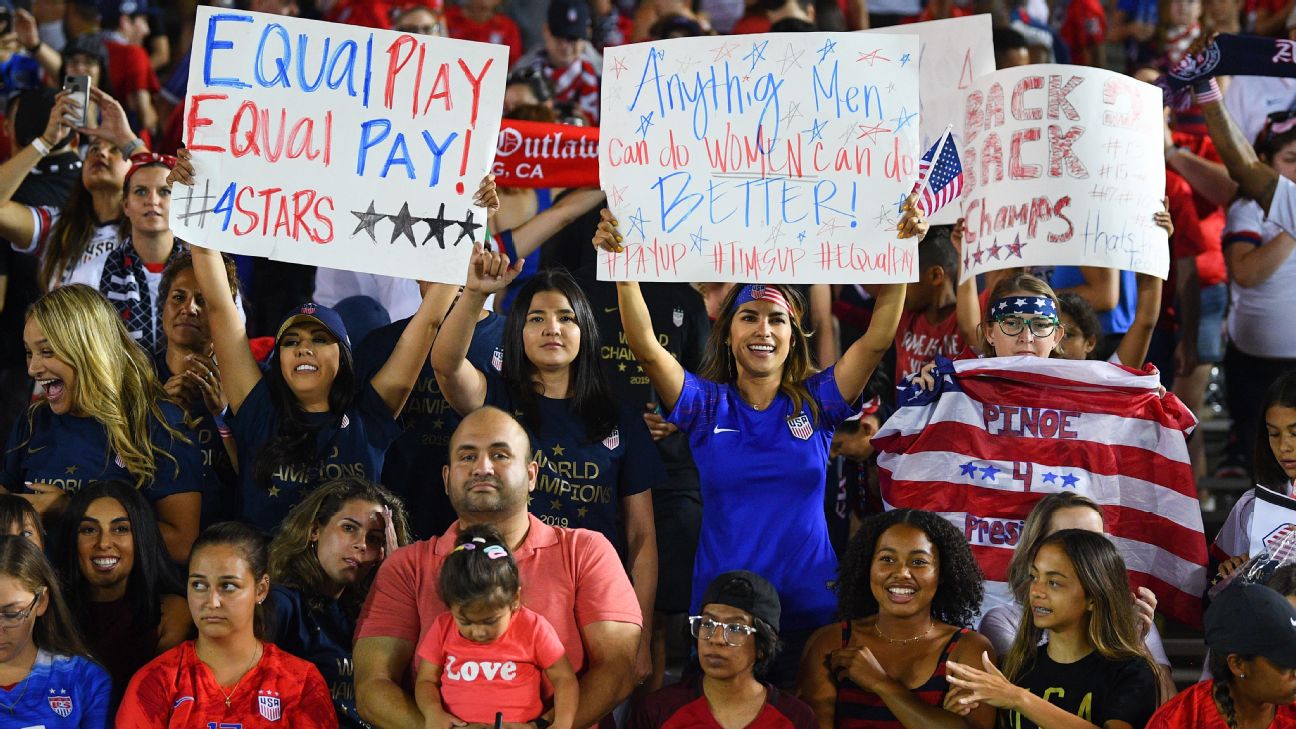The U.S. Soccer Federation filed a brief opposing certification of the players’ class action status late on Monday evening in the equal pay lawsuit involving members of the U.S. women’s national team.
The players first filed their lawsuit on March 8 of this year, alleging that the USSF violated the pay discrimination provisions of Title VII of the Civil Rights Act of 1964 by paying members of the U.S. men’s national team more than those players on the U.S. women’s national team. The suit is also alleging discriminatory working conditions in terms of travel and transportation, medical care, training and nutrition services, and quality of playing surface.
“The members of the MNT have received superior and discriminatory treatment across the board with respect to each of these uniformly applied working conditions,” the players stated in a recent filing.
- Sources: Arsenal block USWNT’s approach for Joe Montemurro
– USWNT star Megan Rapinoe takes FIFA’s The Best prize
– Kaplan: U.S. women’s soccer equal pay fight: What’s the latest, what’s next?
On Sept. 9, the plaintiffs filed a motion requesting that the court certify the players as a class. The motion requested that the court appoint Alex Morgan, Megan Rapinoe, Carli Lloyd and Becky Sauerbrunn as class representatives.
The class designation seeks to award the players injunctive relief for any player who is a team member on the day of final judgement or appeal, as well as back pay and punitive damages for any player on the team at any time between Feb. 4, 2014 to the present.
Certifying a class would allow the players to argue their case as a group and allow any players to opt in to the class. Those who don’t opt in can still sue on their own.
The filing on behalf of the USSF, which was required by the court, contends that the class certification should be denied because from 2014 to 2019, the proposed class representatives — Morgan, Rapinoe, Lloyd and Sauerbrunn — were paid more than the highest earning MNT members “and therefore suffered no injury.”
The filing provides charts comparing the earnings of the four proposed class representatives to the highest-earning USMNT member. For the five-year period in question, Lloyd, Rapinoe, Sauerbrunn and Morgan each earned over $1.5 million (including salaries for playing in the NWSL), while the highest earning men’s player made $993,967. If the NWSL salaries are excluded, Lloyd, Rapinoe, Sauerbrunn and Morgan made just over $1.1 million.
“Plaintiffs also claim that they were subjected to discriminatory terms and conditions of employment under Title VII,” the brief reads. “Noticeably absent from Plaintiffs’ motion for class certification is any evidentiary proof showing that the proposed Class Representatives meet the Article III constitutional standing requirements.
“Because of the lack of proof showing the Class Representatives suffered any injury that could be remedied by this Court’s adjudication of their Title VII claims, Plaintiffs’ motion for class certification should be denied.”
A spokesperson for the players didn’t immediately respond to a request for comment on the USSF’s filing.
It’s worth noting that earnings by players from the USMNT were adversely affected during the period in question due to the team’s failure to qualify for the 2018 World Cup. During 2018, the highest paid men’s player made only $11,250. In 2014, the last time the men qualified for the World Cup, the highest paid men’s player made $391,847.
The players on the two national teams are represented by separate players unions, and have markedly different pay structures in their respective collective bargaining agreements. The men operate on a purely pay-for-play basis in which the only get paid for games when they get placed on a game roster. The bulk of the income for players on the U.S. men’s national team comes from their respective club teams. The women’s CBA specifies that a core group of players are paid a base salary plus benefits, regardless of whether they play in games or not. They are also paid an additional salary for playing in the NWSL. The other “non-contracted” WNT players receive a per-game roster payment for each game they play, in lieu of a base salary amount.
In the Sept. 9 filing, the lawyers for the players asserted that: “For each category of WNT players-contracted and non-contracted players-the per-game compensation they receive, prior to any team performance bonuses, is far less than the per-game compensation, prior to performance bonuses, received by members of the MNT. In addition, the team performance bonuses paid to both contracted and non-contracted members of the WNT are uniform in amount and are less than the bonuses paid to members of the MNT for a comparable team performance. All of these base salary and bonus terms are set forth in the applicable CBAs and applied to all WNT and MNT members.”
The USSF’s lawyers countered: “The Class Representatives’ mere allegations that the WNT and MNT players were paid differently are not the type of ‘evidentiary proof’ showing that they suffered a concrete injury-in-fact that is fairly traceable to U.S. Soccer,” the USSF filing read.
If the court rules in favor of the USSF’s filing, the players can still participate in the lawsuit on their own behalf. Regardless of how the court rules on the USSF filing, the case will continue.
